Lecture
We are on the verge of change, comparable to the emergence of human life on Earth. Vernor Vinge
What is it like to stand here?
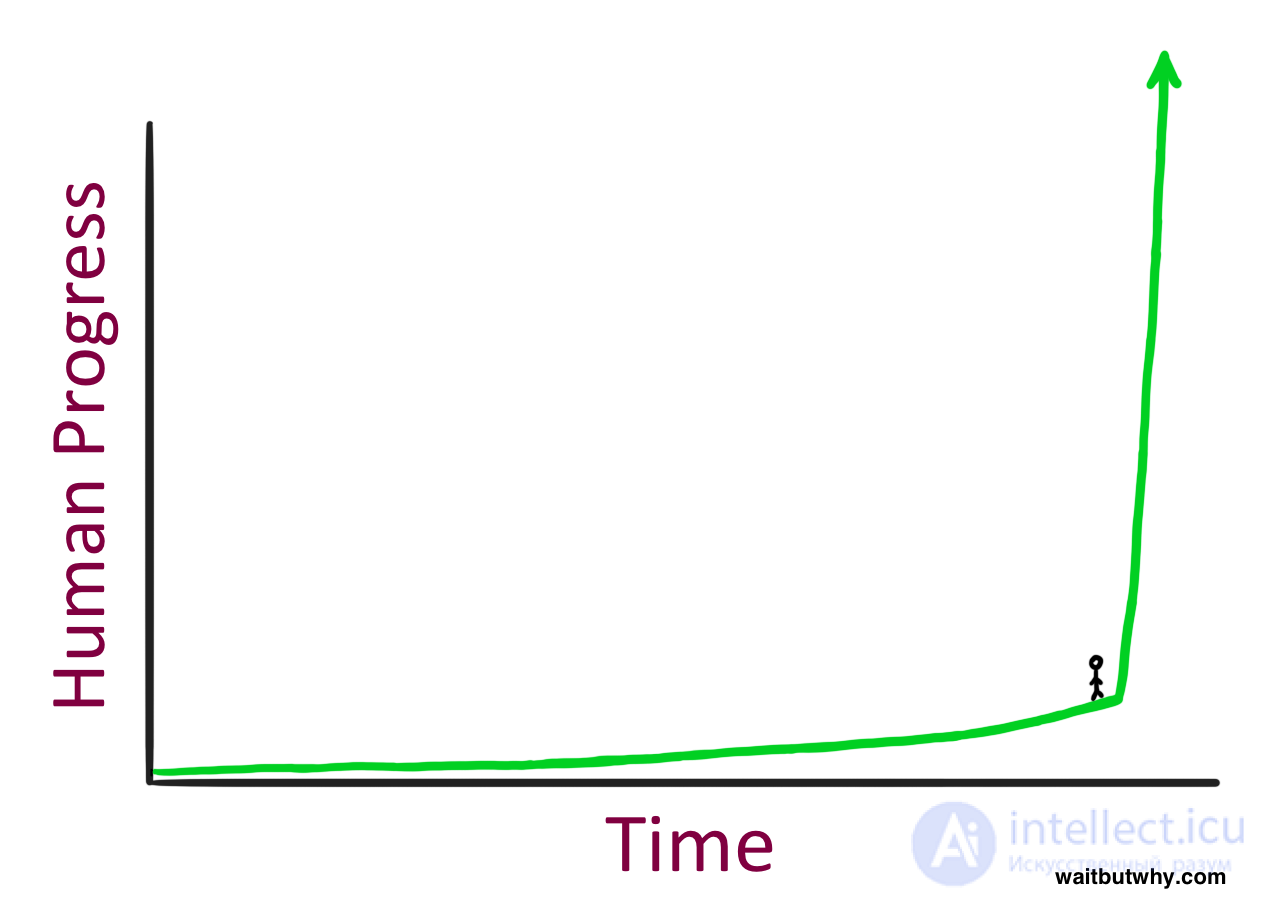
It seems that standing on this place should be quite exciting, but the trick is that being on this line, you do not know what will happen next. So, in fact, it feels like this:
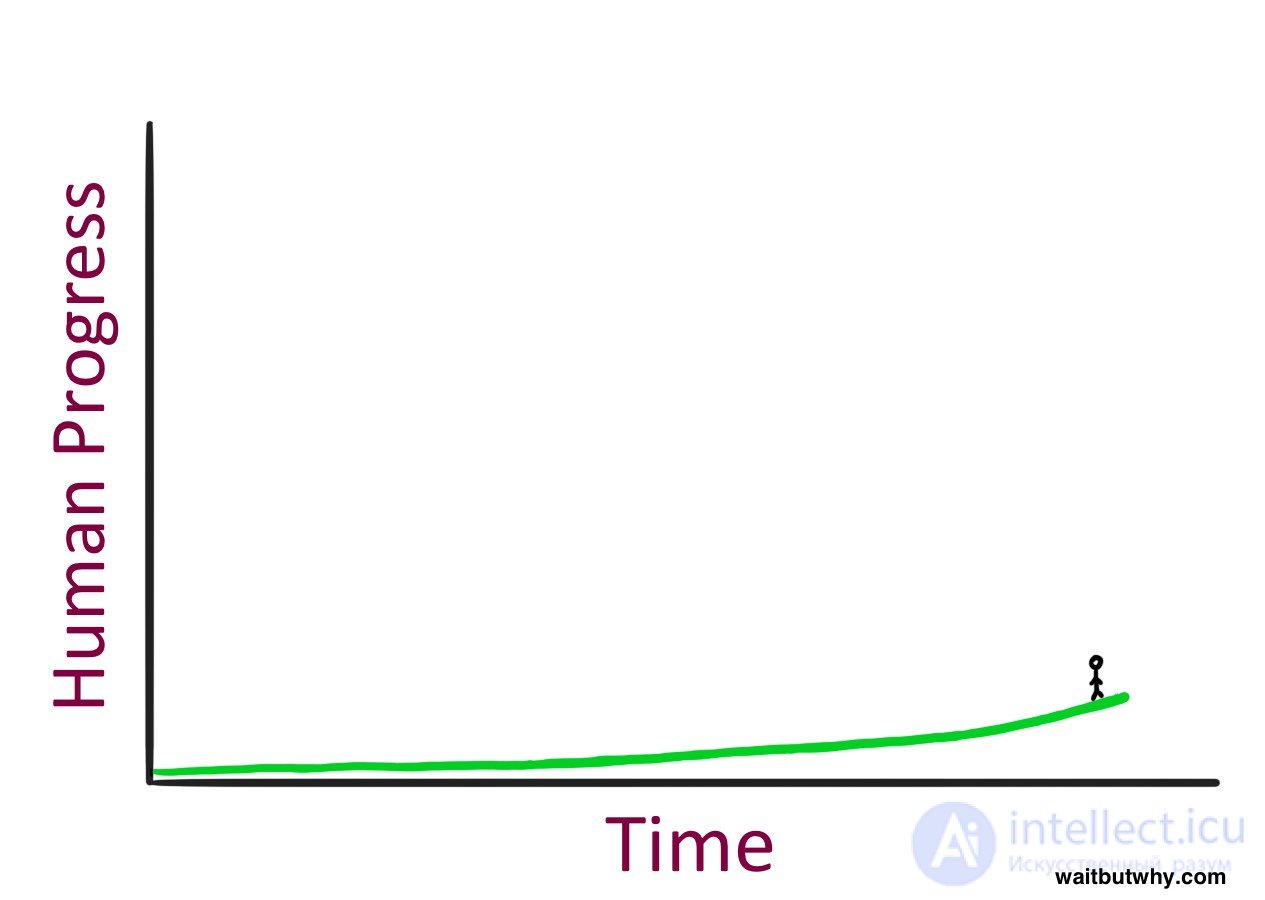
Therefore, we do not feel anything supernatural.
Far future. It will come soon
Imagine that you managed to transfer yourself to a time machine in 1750, where there was no electricity in the world, long-distance communication meant one thing - to yell louder, and all vehicles were fueled with hay. And then imagine that you chose a person there and brought him to our 2015, and then took him outside to see how he reacts to everything. It is difficult to imagine what it would be like for him to see brilliant streamlined cars flying along the highway at a tremendous (for him) speed; talk to people who were on the other side of the ocean a few hours ago; watch competitions running for 1000 miles; hear a musical concert played 50 years ago and play around with your magic thing that can take pictures of real life, or record a living moment of life, or draw a map and show it yourself in the form of a blue dot that shows where it is. See the face of a man and even talk to him, although he is on the other side of the world. And a bunch of other indescribable wonders. And this is all before you show him the Internet and try to explain what the International Space Station, the Large Hadron Collider, nuclear weapons or the Theory of Relativity are.
These discoveries for him will not be a surprise or surprise - these words are not sufficient to describe the depth of his shocks. He may just die from such a shock.
But what is interesting is that if he returns to his 1750 and tries to crank the same thing with his predecessors and returns back to the same 250 years - in 1500, a person from the 1500th will, of course, be surprised by some things - but not fatally. This journey on the degree of madness will be much weaker, since, although the difference between the world 1500 and 1750 exists, they differ much less than 1750 and 2015. Of the 1500, of course, this person learns something outlandish about space or physics, about the new attitude towards imperialism in Europe and will reconsider its ideas about the geopolitical map of the world. But observing the everyday life of the 1750th — transport, communications — he will definitely not die.
In fact, in order for a person from 1750 to have fun just like us, he will have to go much further into the past - perhaps before 12000 BC, before the First Agricultural Revolution gave impetus to the development of the first cities and set a new concept for the development of civilization. If those people from the world of hunting-gathering, who were to some extent just one of the animal species, saw the huge empires of 1750 with their churches-towers, ships crossing the ocean, would know that knowledge is accumulated and passed on from generation to generation - then he would just probably die.
And what if, after he died, he became jealous and he decided to do the same trick with his predecessor? Even if he rewinds back another 12,000 years and turns out to be in 24000 BC and takes a man there with him back to 12000 BC That old man will most likely say: “So what? What the fuck? ”To a man from the 12000s BC will have to rewind back more than 100'000 years to find someone who can be surprised with fire and the ability to speak.
In order for someone to be transferred to the future in order to die there from shock, he must be postponed for a sufficient number of years to get a “lethal dose of progress,” PSD. Thus, the SDP was more than 100'000 years in the era of hunting and gathering, but in the post-agricultural revolutionary period fit into 12000 years. The post-industrial world began to evolve so quickly that a 1750-person needs only 250 years to get the CDS.
This model is the acceleration of the speed of development over time - Ray Kurzweil calls the Law of Self-accelerating Development. It is possible, since more developed civilizations are able to progress with greater speed than less developed ones - precisely because they are more developed. In the 19th century, humanity knew more and had more technology than in the 15th, so it is not surprising, and the speed of progress was higher.
It works with simpler examples. The film “Back to the Future” was released in 1985, and the “past” took place in 1955. In the film, Michael J. Fox returned in 1955, and was amazed that the TV sets were new, surprised at the prices for soda, the unpopularity of the electric guitar and the old-fashioned language. It was a different world - for sure, but if the film was made today, and the past happened in 1985, it would be a film about much, much more striking differences. The hero would have appeared at a time when personal computers, the Internet, cell phones did not exist - today's Marty McFly, a teenager born in the late 90s would feel much more differences than Marty in 1955.
This is how the Law of Self-Accelerating Development works. The average rate of progress between 1985 and 2015 was significantly higher than in the period 1955 - 1985 and much more new appeared in the last 30 years.
Thus, moving forward is becoming more significant and faster. This should lead us to the idea of something significant coming to us from the near future. So?
Kurzweil suggests that the degree of progress realized in the entire 20th century would have been realized in just 20 years, if we take the speed of 2000 progress as an indication. In other words, the speed of progress in 2000 is 5 times faster than the average speed of progress in the 20th century. He believes that the same degree of progress as in the 20th century was already implemented between 2000 and 2014, and the next “20th century” stage of progress will be completed by 2021, after some 7 years. In a couple of decades after that, according to his calculations, the “XX-century” stage of progress will be implemented several times in a single year, and then - and in general - within a month. In short, as a result of the implementation of the Law of Self-accelerating Development, according to the theory of Kurzweil, in the XI century, the degree of human development is 1000 times greater than the degree of human development in the twentieth century.
If Kurzweil and many others who agree with him are right, then perhaps we will have the head off from 2030 to the same extent as the guy from 1750 who happened to be in 2015. In other words, the next “lethal dose of progress” require only a couple of decades, and in 2050 the world can change so much that we may not even be able to fully realize it.
This is not science fiction. This is something that many scientists, much smarter than you or me, firmly believe. And if you delve into history, you will understand that it is completely logical from it.
So why, when you hear, when I say something like “the world in 35 years can be absolutely incomprehensible,” you think “Cool, of course, but .... I don't know ...”. Here are 3 reasons why we are skeptical about the amazing predictions of the future:
1. When it comes to history, we think linearly. When we imagine progress for the next 30 years, we look back at the previous 30 years and use them as an indicator of how much should happen. When we think about the degree of progress in the XI century, we simply take everything that was collected in the twentieth century, and add it to the year 2000. Exactly the same mistake was made by the dude from the 1750th, when he brought someone from the 1500th and expected that Kondraty would suffice from what he had seen, just like he himself had enough in 2015. It is very natural to think linearly, at a time when we must think exponentially. Anyone who is smarter could predict development for the next 30 years, not looking at the previous 30 years, but taking the current rate of progress and relying on it in his reasoning. Of course, he would have gotten closer to the goal, but he would have missed anyway. To think about the future correctly, it is necessary to understand that events in the future will develop much faster than they develop now.
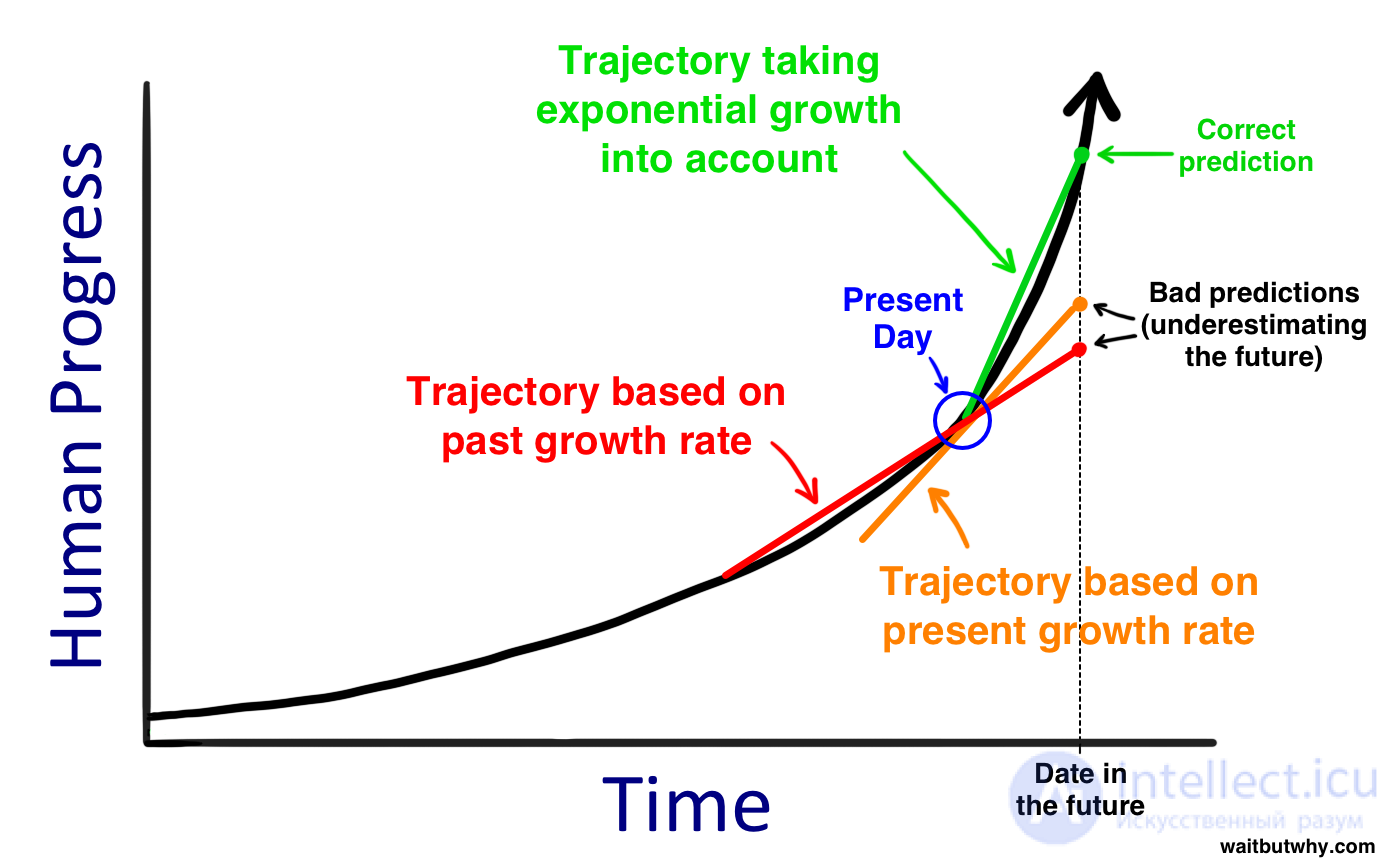
Red - the trajectory of progress based on past speed of development
Orange - the trajectory of progress, based on the current speed of development
Green - the trajectory of progress, taking into account the exponential growth
2. The trajectory of the recent past can give a distorted picture. First, even a steep exponential curve looks like a straight line, if you consider only a small segment of it, just as if you look at a small segment of a huge circle - it seems like a straight line. Secondly, the exponential growth does not have to be smooth. Kurtsevale says progress is S-curves:
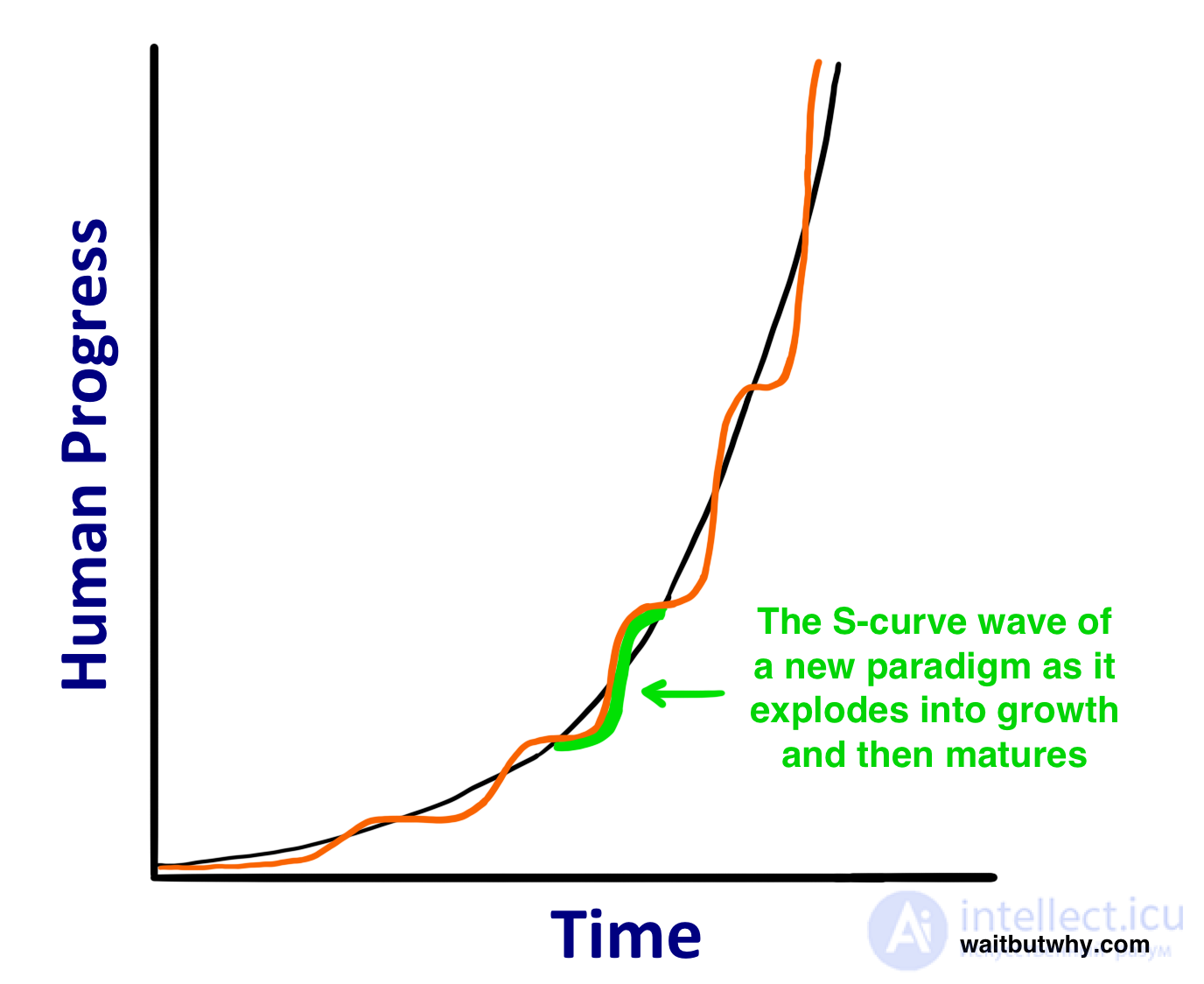
The S-shaped curve is characterized by periodic explosive growth, and subsequent stabilization.
This development curve passes through 3 phases:
1. Slow growth (initial stage)
2. Rapid growth (next, explosive growth stage)
3. Stabilization (formation and existence of the world in the new development paradigm)
If you look at the near past and look at the current part of the S-curve, you can incorrectly estimate how fast progress is. For the period 1995-2007, there was an explosive growth of the Internet, the emergence of Microsoft, Google, Facebook, the birth of social networks, cell phones, and then smartphones - this was the second phase. But from 2008 to 2015, breakthroughs were much less, at least technologically. Someone who is thinking about the future today could make out the last 7 years and formulate a measure of progress - but he will lose sight of the whole picture. In fact, a new era of explosive growth is probably brewing right now.
3. Our experience makes us old obstinate ignoramuses when it comes to the future. We base our ideas on the world on our own experience, and this experience has firmly instilled in our minds the perception of the speed of progress in the recent past into patterns, such as "this is how it happens." We are also limited by our imagination, which uses our experience to form fantasies about the future. However, what we know, as a rule, neither gives us the right tools to predict the future. When we hear a prediction that contradicts our belief about how “it happens”, it is instinctively blocked by our consciousness. If I tell you, further in the text, that you may be living up to 150-250 years old, and maybe you will never die at all, you will instinctively object “Nonsense! If I have at least learned something from history, it is that we will all die! ” And this is true - no one in the past has lived forever. But no one flew on planes until they were invented!
Most likely, while the feeling of “yah, nonsense! ...” seems true to you from reading this article, but perhaps it will pass when you know everything I want to tell. The facts say that if we simply follow the logic and expect that the previous development models will continue to exist, we should expect that much, much more will change in the near future than we can imagine. Logic also suggests that if the greatest minds on Earth continue to move progress at the same accelerating pace, after a while we will all make such a strong leap in development that it will completely change the life we know it and the understanding of what is really developed civilization. If you spend some time learning about what is happening today in science and technology, you will see many signs that suggest that life in its current manifestation will change drastically.
--------------------–-----------------------------
The Path to Super Intellect
What is artificial intelligence?
Most likely, you perceived the concept of “Artificial Intelligence” as some kind of science fiction bike, but recently you heard a couple of times how quite reasonable people seriously mentioned this concept. And it does not fit.
There are three reasons why people misunderstand the concept of Artificial Intelligence:
1. We associate it with feature films. Star Warriors. Terminator. Matrix. This is fantastic, as well as stories about live robots. Movies are forced to perceive artificial intelligence as science fiction.
2. Artificial intelligence is a very broad concept. It is in calculators and self-driving cars. He is also Something that can change our world. Artificial intelligence applies to all of these concepts and it is confusing.
3. We use Artificial Intelligence constantly in everyday life, unaware that this is He. John McCarthy, who introduced the concept of Artificial Intelligence in 1956, said: "as soon as it starts to work, we no longer call it that." Because of this phenomenon, “Artificial Intelligence” usually sounds more like a mystical prediction of the future than a reality. At the same time, it is perceived as a popular concept from the past that has not been realized in the present. Ray Kurzweil says that hears people saying that the concept of AI has outlived itself in the 80s, and compares this approach with the statement that the Internet died after the dotcom crash in 2000.
Let's see. First, let's stop imagining robots. A robot is a container for Artificial Intelligence, which may or may not have a human-like shape. Artificial intelligence is a computer inside a robot. Artificial intelligence is the mind, the robot is the body. For example, Apple's Siri software is Artificial Intelligence, and the female voice to which he “speaks” is the personification of this Intellect, there is no robot in the physical sense at all.
Secondly, you may have heard the term "singularity" or "technological singularity." This term is used in mathematics to describe a graph in the form of assymptotes, where the normal rules no longer work. In physics, it is used to describe an infinitely small dense black hole or a point into which the entire Universe shrank at the moment before the Big Bang. Once again, this is a situation in which the usual rules no longer work. In 1993, Vernor Vinh wrote a popular essay in which he defined the singularity as a moment in the future when the intelligence of our technologies exceeds our own — the moment when the life we know changes completely and the normal rules stop working. Later, Ray Kurzweil confused everything a bit, defining the singularity, as the moment of time when the Law of Self-Accelerating Development reaches so fast speed that technological progress will occur at infinitely fast speed, the moment after which we will live in a completely new world. I discovered that today's AI thinkers have stopped using the term “singularity”, since its meaning is, of course, somewhat confused. Therefore, I will not use it too much here (although the concept runs through this article).
And finally, since there are many types of AI (since AI is such a broad topic), it is worthwhile to single out several types of Artificial Intelligence, differing in scale.
There are three categories of Artificial Intelligence scale:
1. Specialized Artificial Intelligence (FIC). Sometimes referred to as weak AI. This is the artificial intelligence that specializes in one area. There is an AI who will beat the world chess champion, but this is the only thing he can do. If you ask him how best to save the data on the hard disk, the answer is silence.
2. General Artificial Intelligence (OII). Sometimes referred to as a strong AI or human level Intellect. This is the kind of intelligence that can compete with a person in all areas. Creating an AIS is a much more complicated task than creating an AII, and we still have to do it. Prof. Linda Gottfredson describes rationality as “broad mental abilities that include, among other things, the ability to reason, plan, solve problems, think abstractly, understand complex ideas, learn quickly and learn from mistakes.” OII will be able to do these things as easily as you do.
3. Super intelligence. Oxford professor and leading expert in AI, Nick Bostrom, defines Super-intelligence as “intelligence that transcends the best human minds in all areas, including scientific creativity,“ universal human wisdom and social intelligence ”. The concept of "Super-intelligence" includes both a computer, not much superior to the human mind, and a machine that is a trillion smarter. Absolutely all indicators. Super intelligence is the reason why the Artificial Intelligence topic is so important. This is the reason why buzzwords like immortality or extinction will appear in my articles on this topic more than once.
So, today, humanity has been able to cope with the first level of AI - Specialized Artificial Intelligence. He is a reality in many areas, existing, in fact, everywhere. The Artificial Intelligence Revolution is the path from the AIS through CSI to the Super Intellect. This is a way that we humans can not survive, and which, in any case, will change everything.
Let's see what the leading minds of our world in the field of Artificial Intelligence say about this Path and why this revolution can happen faster than you think:
Now we live in a world that exists thanks to the work of the AII:
Specialized Artificial Intelligence is an intellect superior to human intellect or performance in a narrow area. A few examples:
If you’re cracked with FIC: It’s possible that it’s self-guided cars.
Your phone is a small FIC factory. Do you need to use your phone?
Your spam filter in email is nothing like FIC. He wants to know what he needs to do.
If you’re familiar with these annoying “Recommended for you” messages? Or when Facebook suddenly invites you? This is where the FIS systems are working. This thing also works on Amazon "people who bought the same product also bought this one ...". It is an order of
Google Translator is another classic FIC system that works impressively well in its narrow area. It is a number of words.
He should approach. Just like the computer decides at a price.
The world's best chess players, scrabble and other games - FIC systems.
Google Search is essentially one large FIC. The same works for Facebook news feeds.
And this is only the world of consumers. Complex FIC systems are widely used in the US stock market. Watson supercomputer. All this is Specialized Artificial Intelligence.
Do not make a dangerous impression. FIC system can be caused by the catastrophe, such as the de-energizing It wasn’t been a trillion system when it wasn’t corrected,
but it’s not correct. , it should be considered that it is already in its own way.IES and Super Intellect. Or, as Aaron Saenz says, “It is an inanimate substance of the world,”
Why is it so hard
Nothing will make you feel the greatness of the human mind like learning how difficult it is to make a computer as smart as a person. Building skyscrapers, conquering space, exploring the details of the Big Bang is all much easier than understanding how our brain works or how to do something similar. Today, the human brain is the most complex object in the Universe that we know about.
What is interesting, the difficult part in developing an OII (a computer as reasonable as a person as a whole, and not just having the only outstanding characteristic) is not what you most likely thought of. Building a computer that multiplies two ten-digit numbers in a fraction of a second is easy. It is extremely difficult to create one that, having looked at the dog, will immediately answer whether it is a cat or a dog. Create an intellect who will replay the chess champion? - Made! Create one so that after reading a paragraph from a book for 6-year-old children not only recognize words, but understand their meaning? Google now spends billions of dollars to implement it. “Difficult” tasks for us, such as complex calculations, analysis of financial markets, language translations are simple for a computer. “Simple” tasks, such as sight, movement, perception, are incredibly difficult for him. Or, as a computer scientist, Donald Knut, says, “Artificial intelligence has succeeded today in everything that requires“ thinking ”, but failed in tasks that people and animals do without thinking.”
What you quickly understand when you talk about it is that things that seem simple to us are actually very complex. And they seem simple only because certain abilities have developed in us (and many animals) over hundreds of millions of years of Evolution. When you stretch your hand to an object, the muscles, tendons and bones in your shoulder, elbow and wrist instantly perform a long series of physical operations in collaboration with your eyes to allow you to move your hand in a straight line in three dimensions. It seems to you that this happens by itself, because the “software” in your head has optimized its work for many years. The same applies to the situation where bot programs cannot pass an elementary word recognition test on any site at the time of registration - this is not because bots are so primitive, but because your brain is so perfect.
On the other hand, the multiplication of large numbers or the game of chess is a fairly new activity and we did not have enough time to train our abilities for these types of tasks, so the computer will easily beat us in this field. Consider - what would be easier - to develop a program that can multiply large numbers, or one that understands the designation of the letter “B” so well that you could distinguish it in any of the thousands of unpredictable fonts or handwriting of thousands of people?
One funny example is when you look at this picture, you and the computer can easily figure out that this is a rectangle in two alternating shades:
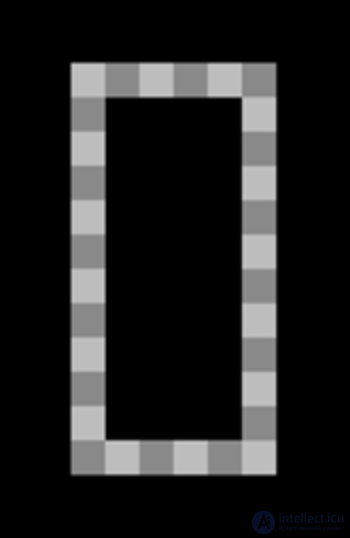
For now - the score is equal. But if you pick up a black sheet, and open the whole picture:
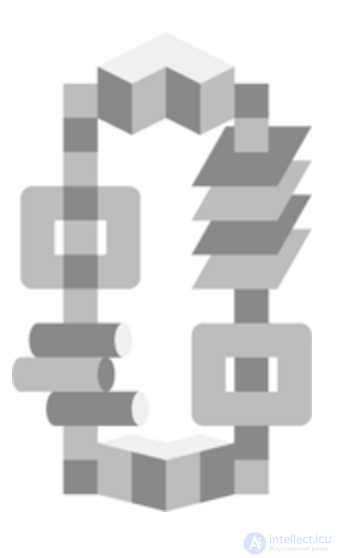
... you can easily describe this puzzle from transparent and opaque cylinders, bagels and voluminous corners, and the computer will fail on this test completely. He will describe what he sees: a set of two-dimensional parts in 7 different shades, which they really are. Your brain analyzes heaps of diverse information to correctly interpret the actual shape, the game of shadows, and the degree of light. Looking at the next picture, the computer sees a flat collage of white, gray and black colors, although you will immediately realize that this is a black stone:

And all that we have just talked about concerns only static information. To be reasonable, as a person, the computer will have to learn to recognize minor shades of facial expressions, the differences between the concepts of "satisfied", "satisfied", "reassured" and "pleased." And why “Braveheart” is a cool film, and “Patriot” - sucks.
It is not simple.
But how to get there?
The first key to the creation of Artificial Intelligence: an increase in speed and computing power.
The first thing that must happen in order for OII to become possible is an increase in the power of computer hardware. So that the AI could be as intelligent as the human brain, it will have to catch up with the brain in computing power. One way to express this characteristic is the total number of operations per second (cps) that the brain is able to implement. This value can be calculated by adding the speed of each section of the brain.
Ray Kurzweil developed a technique based on expert estimates of the speed of operations in one of the sections of the brain, and then the weight of this section is compared with the weight of the whole brain and multiplied proportionally to estimate the total figure. It sounds rather clumsy, but he did it many, many times with different professional assessments of different parts of the brain, and the total figure almost always aimed at 10 ^ 16 or 10 quadrillion operations per second.
To date, the fastest supercomputer, the Chinese Tianhe-2 has surpassed this figure with its 34 quadrillion operations per second. But Tianhe-2 essentially loses to the brain in other parameters with its 720-meter building and even consumption of 24 MW of electrical power (the brain works at 20 W) at a price of 390 million dollars. Such a supercomputer is completely unsuitable for widespread use, and is also not suitable for most industrial or commercial tasks.
Kurzweil suggests that we evaluate computers based on how much speed (cps) we acquire for $ 1,000. And when we can get for $ 1000 “human” 10 ^ 16 cps, then we can assume that the General Artificial Intelligence can become a part of our life.
Moore's Law, a historically confirmed rule, states that the World Maximum Computing Power doubles in about 2 years, meaning that the development of computer hardware, as well as the general development of human civilization, occurs exponentially. According to Kurzweil's classification (in the context of “cps for $ 1000”) we are now at the level of 10 trillion (10 ^ 13) cps for $ 1000 and are moving along the following trajectory:
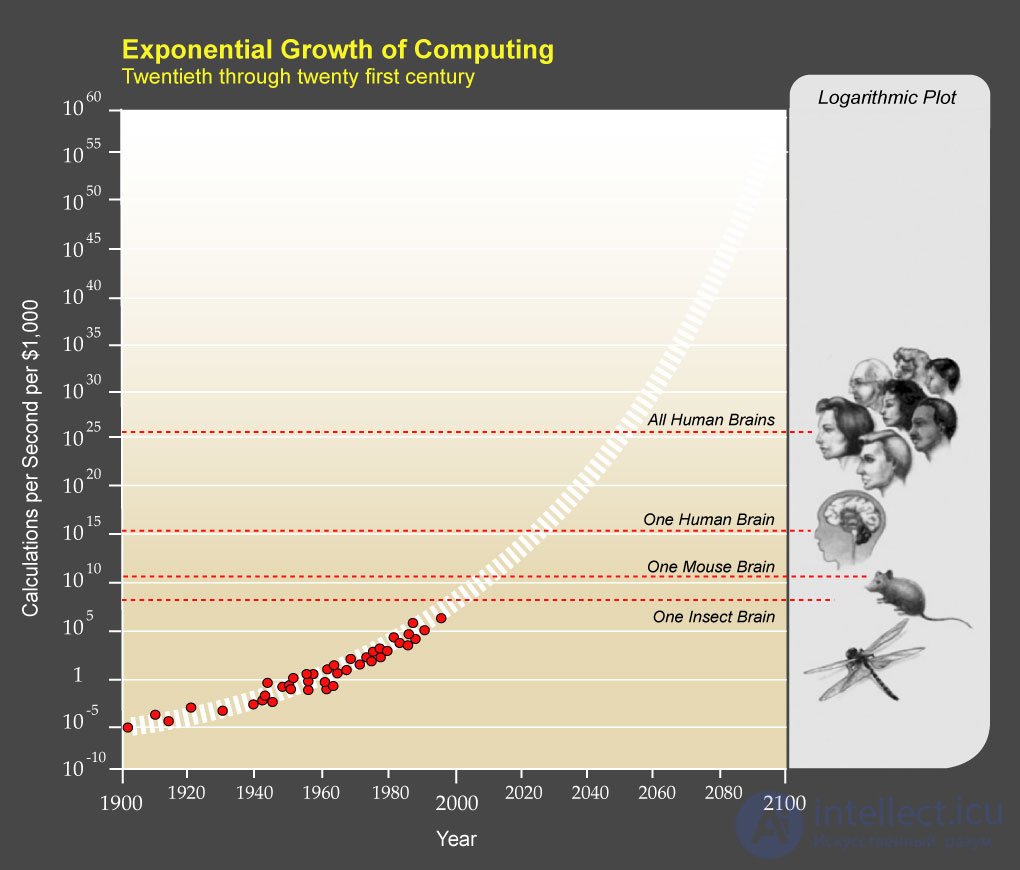
Those. today's computers for $ 1000 surpass the mouse brain, but their performance is only about a thousandth of a human one. It seems small, but only until you remember that in 1985 the speed of a computer was one trillionth of human, billionth of 1995 and millionth of 2005. Being in the thousandth in 2015, we will reach parity by 2025 at this rate.
Thus, in terms of iron, the computational power required for the implementation of OII is technically available now in China. And we can expect that affordable and widespread iron-level OII will appear in the next 10 years. However, computing power alone will not make a computer reasonable — the next question: how do we combine human intelligence and this computing power?
The second key to making CSI: Make it reasonable
Here is the problem. The fact is that no one knows for sure how to make a computer sensible - scientists still argue about how to bring the computer's “intelligence” to the human level, that is, for example, explain how to distinguish a dog from any other animal; or the letter "B", written in an unusual handwriting; or distinguish mediocre from excellent movie. There are several theories about this, and one day one of them will work. Here are the three most advanced ones:
1. Copy the human brain.
The closest analogy - as if scientists carefully studied the student at the next desk, who coped with his studies, and carefully tried to figure out how he does it. But with all the efforts they couldn’t even come close to his results, so in the end they gave up: “to hell with him - just write off his words!” This strategy makes sense - we are at a dead end, developing super-complex computers, and here - a perfect prototype in every (almost!)) Human head.
The scientific world is working intensively on the reverse engineering of the human brain to figure out how Evolution managed to create such a cool thing - and optimistic forecasts suggest that we will be able to do it by 2030. As soon as this happens, we will learn all the secrets of the highest efficiency and productivity of the brain and will be able to copy these mechanisms to implement Super Intelligence. One example of computer architecture that uses the principles of the brain is an artificial neural network. It is a network of transistors - neurons connected to each other with their "inputs" and "outputs", and at the initial stage "does not know" anything - absolutely pure lit. The system starts learning, trying to accomplish a task, for example - to recognize handwritten text. And at first her attempts to guess the letters will be completely messy. But as soon as she was informed that she had done something right, the order of connecting the transistors, which led to the correct answer, gets higher priority. When the system is wrong, the corresponding connections are lowered in priority. As a result of a large number of iterations by the trial and error method, the system is self-optimized for the performance of a specific task. The brain works in a similar way, but in a more complex variation. And, studying the brain, we discover elegant and very effective techniques for creating and using neutron networks.
More sophisticated plagiarism involves a strategy called emulation of the whole brain. The task of the strategy is to examine the brain layers by scanning and developing its three-dimensional model for its subsequent integration into a powerful computer. Then we would have a computer with the capabilities of the human brain - it only needs to learn and gather information. If the engineers succeed in their plans, they will be able to recreate the brain so precisely that the person’s personality and all the memories can be downloaded to the computer. If, prior to the experiment, the brain belonged to Jim, the computer will “wake up” to Jim (read more about what makes up the person’s personality here), and it will be the system of General Artificial Intelligence. And after that, we can start working on turning Jim into an unimaginably intelligent Super Intelligence. He will definitely like it.
How far are we from complete imitation of the human brain? To date, it has been possible to imitate the work of the brain of a 1mm worm, consisting of 302 neurons. The human brain contains 100 billion neurons. It may seem like a senseless struggle, but think of the power of exponential progress: now we have defeated the little worm, soon, perhaps, we will catch up with the ant, and then the mouse. And suddenly the ultimate goal will be very real.
2. Try to force Evolution to do for the computer what it has already done for us.
If we decide that copying the success of that student is too difficult, then we can try to figure out how he is preparing for new exams.
Here is something we know: it is possible to build a computer equal in performance to the human brain. But if the brain itself is too complicated to copy, we could copy the Evolution methods instead. In fact, even if we could copy the brain, it could still be something of an attempt to build a plane, trying to copy the flapping wings of a butterfly. It often turns out that it is more efficient to create machines from scratch using a modern, mathematically optimized approach, instead of direct copying of biological processes.
But how can we simulate Evolution to create an OII? The method called “genetic algorithms” should work this way: it is necessary to start the process of performing operations and then evaluating its effectiveness (exactly the same that occurs in the biological world when living creatures live life and are “evaluated” as a result of successful (or not successful ) breeding). A group of computers would reproduce some work, and the most successful of them “mated” among themselves, combining half of their software code into a new computer. Less successful would be destroyed. As a result of a large, very large number of such iterations, this selection would produce more and more sophisticated computers. The challenge is to create an automatic process of assessment and reproduction so that this process can develop on its own.
The disadvantage of this method is that evolutionary processes last a billion years, and we would like to meet a couple of decades.
But we also have advantages over evolution. First, evolution is haphazard, producing much more unnecessary mutations than useful ones. And we could control and direct the process, so that he would move in the direction of really necessary improvements. Secondly, Evolution has no goal, including the achievement of reason. Sometimes Evolution works even against the intellect (since the brain uses a large amount of energy). We, on the contrary, could direct this process in the direction of increasing intelligence. And thirdly, if Evolution had chosen for itself the path of development of the intellect, it would have to optimize additionally a bunch of additional things - like reconsidering the process of energy production in the cell. While we could just get rid of the solution to this problem, using external electricity. No doubt, we would have coped with this task better than Evolution. However, it is still not clear whether we can evolutionally develop Artificial Intelligence sufficiently.
3. Make it all a computer problem, not ours.
This option comes up when desperate scientists begin to try to force the task to solve itself. Interesting, but perhaps this is the most promising method.
The idea is to build a computer, whose main task would be to do research in the field of Artificial Intelligence and reprogram itself, allowing it not only to learn, but to improve its own architecture. We would teach computers to be computer scientists, so that they can manage the process of their own improvement themselves. And that would be their only task: to figure out how to make themselves more reasonable. Further - more about this.
All this can happen very soon.
Intensive improvements in computer hardware and innovative software experiments are constantly occurring and General Artificial Intelligence can come to life very quickly and unexpectedly for two main reasons:
1. Exponential growth happens very quickly and what looks like a subtle improvement can quickly become an all-encompassing avalanche. Look at the picture:
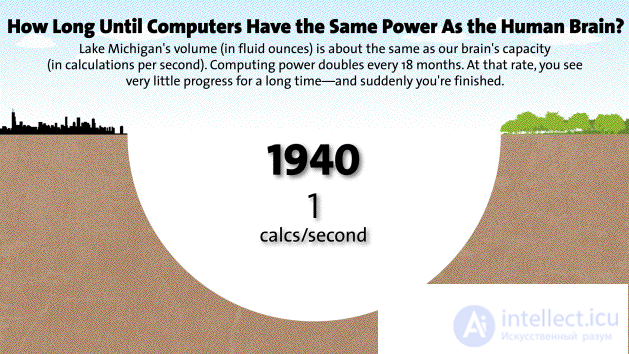
The volume of Lake Michigan in ounces is approximately equal to the capabilities of our brain (in operations per second). The calculation speed doubles every 18 months. At this speed, progress is barely noticeable for a long time, and ... suddenly, everything is over
2. When it comes to software, progress may be slow, but then some unexpected discovery instantly changes the speed of development (for example, for a long time humanity had great difficulty understanding the Solar System, and then discovering that all the planets move around the Sun , suddenly made everything much easier). Or if the question concerns a computer that improves itself: it may seem to us that the system is at the very beginning of the path, but after a moment of time it turns out that it is already 1000 times more efficient and approaches the level of human intelligence.
Road from General Artificial Intelligence and Super Intellect
One day we will reach General Artificial Intelligence - computers with a “human level of intelligence”. It turns out such a commune of people and computers living in equality.
Actually, not quite ...
The thing is that OII with an identical human level of intelligence and computing power will still have undeniable advantages over a person:
Iron:
Speed. The maximum “rate of fire” of neurons is around 200 Hz, while today's microprocessors (which are much slower today than they will be when we get to the OII) operate at 2 GHz, or 10 million times faster than our neurons. And the speed of data transmission in the brain, reaching 120 m / s, hopelessly lags behind the computer speed of communication over optical fiber, flying at the speed of light.
Size and volume. The brain is locked into the skull, and its size is limited. Другое ограничение — это опять — скорость в 120 м/с, которая не позволит с приемлемой скоростью производить коммуникации в сети, созданной из нескольких человеческих голов. Компьютеры можно расширять до неограниченного размера, и добавлять неограниченное количество новых мощностей, оперативной памяти, и места на жестком диске. Все эти параметры компьютеров имеют гораздо большую емкость и точность, чем человеческого мозга.
Надежность и выносливость. Не только память компьютера точнее человеческой. Транзисторы — надежней человеческих нейронов, они менее склонны к порче со временем (а если какие-то испортятся, их можно просто заменить на новые). Человеческих мозг также подвержен утомляемости, в то время как компьютеры могут работать на полной мощности круглосуточно в течение очень длительного времени.
Программное обеспечение:
Редактируемость, возможность внесения улучшений и бОльшие возможности. В отличие от человеческого мозга, компьютерное программное обеспечение может получать обновления и исправления, что позволяет экспериментировать с ним. Улучшения могут быть реализованы в тех областях, где возможности человеческого мозга ограничены. Алгоритмы зрения человека феноменально совершенны, в то время как технические возможности системы зрения достаточно посредственны. Компьютеры смогут соперничать с человеком в области алгоритмов зрения, и кроме того получить значительные усовершенствования в области «железа».
Коллективная работа. Люди превзошли все живое в области накопления и распространения знаний. Начиная с создания языка и объединения в большие и сложные социальные объединения, продвигаясь вперед с изобретением письменности и печати, а теперь еще более ускоряясь с использованием интернета, Коллективное Человеческое Знание — это главная причина такого превосходства человека над всем остальным животным миром. А компьютеры будут гораздо круче нас в этом: всемирная сеть Искусственного Интеллекта, работающая по одной программе, могла бы регулярно синхронизировать накопленные знания во всех отдельно взятых компьютерах, и таким образом, все, что стало известно одному из них тут же тиражировалось бы на всех остальных. Такая сеть могла бы также объединить усилия, работая над одной задачей, и главное — этой сети будет неведомо инакомыслие или эгоизм, которые часто тормозят развитие человеческой цивилизации.
Искусственный Интеллект, который скорее всего подойдет к уровню ОИИ через программу самооптимизации, не будет рассматривать «человеческий уровень разумности» как какую-то важную веху (это имеет значение только для нас) и вряд ли остановится на достигнутом. А понимание преимуществ, которые будет иметь любая ОИИ-система «человеческого уровня разумности», делает очевидным тот факт, что она преодолеет человеческий уровень и за мгновение «улетит» в области подлинного Супер-интеллекта.
И когда это произойдет, это, скорее всего, будет для нас серьезным потрясением. Причина в том, что с нашей точки зрения: а) наша разумность превосходит разумность всего, что нас окружает; б) мы считаем, что умные люди — гораздо умнее, чем глупые. Как-то так:

Наше узкое понимание разумности: среднестатистический человек, находясь в интервале между Эйнштейном (оранжевая линия) и каким-нибудь сельским дурачком (зеленая линия), свысока посматривает на ИИ: «Ха, как забавно этот робот пытается повторить обезьяньи трюки!»
До тех пор, пока ИИ продвигается вверх в степени разумности, мы рассматриваем его просто становящимся умнее, по сравнению с животным. После того, как ИИ достигнет нижней планки человеческой разумности (Ник Больстром использует понятие «деревенский дурачок»), мы будем умиляться «О, как мило! Он прямо как тот дурачок!». Только фокус в том, что диапазон человеческих возможностей (от идиота к Эйнштейну) находится в относительно коротком промежутке, поэтому СРАЗУ после преодоления уровня «дурачок» и провозглашения системой ОИИ, Система окажется умнее Эйнштейна и мы вдруг окажемся перед фактом:
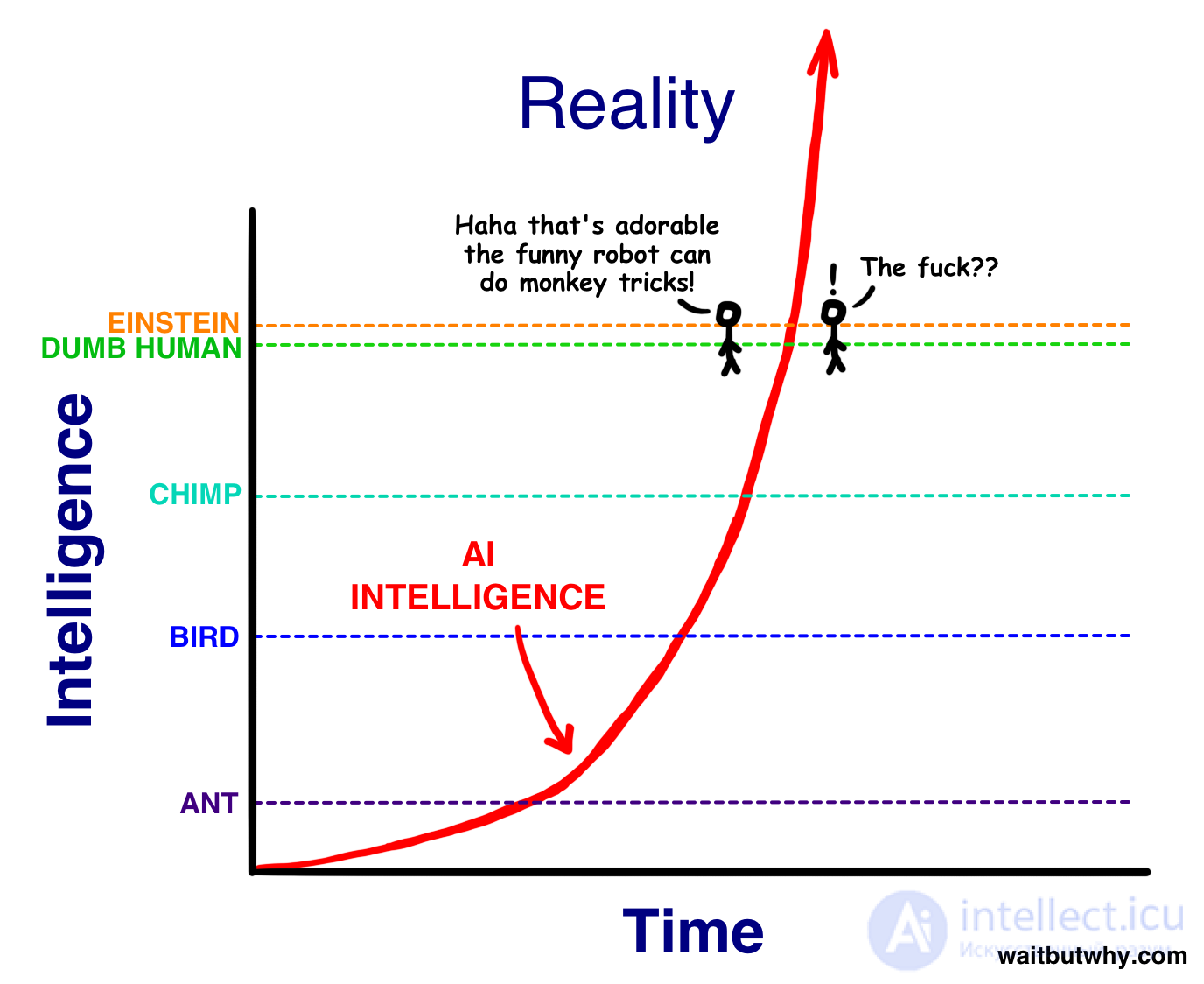
а что произойдет после этого?
Взрыв интеллекта
Я надеюсь, вы насладились «нормальной» историей, потому что сейчас эта тема станет совсем непривычной и даже страшной, и чем дальше рассказ — тем серьезней. Я хочу сделать паузу и напомнить вам, что абсолютно все, что вы прочитали и прочитаете в этой статье реально: реальная наука, реальные прогнозы будущего от самых известных и уважаемых ученых и мыслителей. Просто помните об этом.
В любом случае, как я уже сказал, большинство моделей используемых для разработки ОИИ используют механизмы самооптимизации. А как только они приблизятся к уровню ОИИ, даже системы, которые не используют самооптимизацию, будут уже достаточно разумны, чтобы самостоятельно включить эти механизмы, если захотят.
И тут мы снова возвращаемся к Закону Самоускоряющегося Развития, который будет здесь работать следующим образом: система ИИ на определенном уровне разумности, скажем — уровне деревенского идиота, программируется на улучшение собственного интеллекта. Как только он выйдет на следующий уровень, пусть будет — уровень Эйнштейна, он сможет продвигаться быстрее и делать бОльшие скачки в развитии. Эти скачки сделают его значительно умнее любого человека, позволяя делать еще бОльшие скачки. С увеличением расстояния этих скачков и увеличением их частоты, ОИИ взлетит на недосягаемый уровень и тогда перейдет в разряд Супер-интеллекта. Это и называется Взрыв Интеллекта.
Существуют разногласия по поводу срока преодоления Искусственным Интеллектом уровня человеческой разумности: средний прогноз, на основании опросов сотен ученых, которых спрашивали, в каком году мы с высокой вероятностью преодолеем эту планку, указывал на 2040 год. Иначе говоря — не позднее, чем через 25 лет. Это цифра не выглядит пугающе, но это если не принимать во внимание, что следующий переход (от ОИИ к Супер-интеллекту) произойдет ОЧЕНЬ быстро. Может произойти нечто подобное:
Десятилетия понадобятся, чтобы создать систему искусственного интеллекта, достигающую нижнего уровня ОИИ, но это все равно произойдет — компьютер, способный воспринимать мир на уровне 4-летнего ребенка. А после этого, совершенно для нас неожиданно, в течение какого-то часа, система овладеет общей теорией физики, которая объединяет общую теорию относительности и квантовую механику — то, чего пока не смог сделать ни один человек. Еще через полтора часа ОИИ станет Супер-Интеллектом, будучи уже в 170'000 раз умнее человека.
Супер-Интеллект такого уровня — это то, чего наш мозг не сможет воспринять, так что шмель смог бы понять больше из Кейнсианской теории экономики. В нашем мире умный — значит IQ=130, а глупый — значит IQ=85. Но у нас нет слова для IQ=12'952.
Что мы знаем наверняка, так это то, что полное превосходство человека на Земле предполагает простое правило: с Интеллектом приходит Могущество. Это означает, что Супер-Интеллект станет самым могущественным созданием на Земле и все живое будет полностью в его власти. И ВСЕ ЭТО МОЖЕТ ПРОИЗОЙТИ УЖЕ В БЛИЖАЙЩИЕ ДЕСЯТИЛЕТИЯ.
Если мы со своим скромным мозгом смогли изобрести wi-fi, тогда Нечто в 100, 1000 или 1 миллиард раз умнее нас сможет без проблем контролировать положение каждого атома в мире так, как ему это нравится, в любое время — то есть сможет все то, что мы считаем чудом. Все способности, которые мы приписываем всемогущему Богу, будут такими же обыденными для Него, как для нас — включение света в комнате. Изобретение технологии, которая остановит старение, вылечит любую болезнь, победит голод, сделает постоянно хорошую погоду — чтобы сохранить жизнь на Земле и сделать ее комфортной — все это вдруг станет совершенно возможно. Так же, как и возможен моментальный конец всей жизни. Поэтому, рассуждая об Искусственном Интеллекте, надо понимать, что речь фактически идет о Боге Всемогущем на Земле. И тут возникает главный вопрос:
Будет ли это добрый Бог?
продолжение следует...
Часть 1 The Artificial Intelligence Revolution - The Path to Super Intellect
Comments
To leave a comment
Artificial Intelligence
Terms: Artificial Intelligence